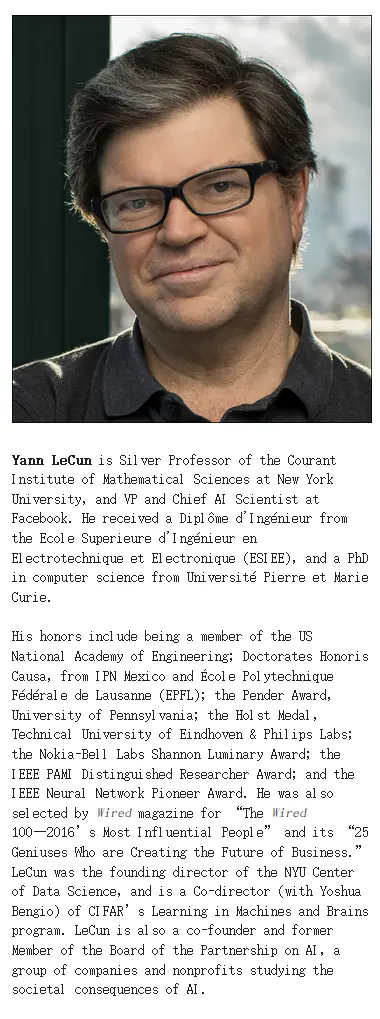https://awards.acm.org/about/2018-turing
众所周知的深度学习三巨头: Yoshua Bengio, Geoffrey Hinton, Yann LeCun 三人共同拿下本年度的图灵奖,以表彰他们在人工智能领域内所做的贡献。
图灵奖是计算机领域内的最高奖项。以著名的计算机科学家艾伦图灵的名字命名,由ACM设立,每年颁发。
这里我们还是重点关注三位的selected accomplishment。也即主要的工作成就:
首先是Hinton
Geoffrey Hinton
Backpropagation: In a 1986 paper, “Learning Internal Representations by Error Propagation,” co-authored with David Rumelhart and Ronald Williams, Hinton demonstrated that the backpropagation algorithm allowed neural nets to discover their own internal representations of data, making it possible to use neural nets to solve problems that had previously been thought to be beyond their reach. The backpropagation algorithm is standard in most neural networks today.
Boltzmann Machines: In 1983, with Terrence Sejnowski, Hinton invented Boltzmann Machines, one of the first neural networks capable of learning internal representations in neurons that were not part of the input or output.
Improvements to convolutional neural networks: In 2012, with his students, Alex Krizhevsky and Ilya Sutskever, Hinton improved convolutional neural networks using rectified linear neurons and dropout regularization. In the prominent ImageNet competition, Hinton and his students almost halved the error rate for object recognition and reshaped the computer vision field.
这里主要提到了Hinton的三个工作:BP,玻尔兹曼机,以及对CNN的改进。
BP的重要性自不必多言,通过BP为网络“学习”过程提供了一个通用的方法,在几乎所有的网络中都在用。我们知道,对于凸优化问题,我们将其划分为各种类型,并且给出求解方式。但是对于数学模型复杂的、不能保证凸性的神经网络,BP算法是一个应用广泛且效果良好的方法。有了BP,实现网络的优化这一问题就不太成为一个困扰了,人们可以将更多的想法放在模型结构和算法设计上,而对网络的优化过程则直接利用BP实现。自然,这是一个很有意义的工作。
玻尔兹曼机是最早的神经网络模型之一,而且现在在有些场景也仍在应用。它的作用是可以学到internal representation,也就是内在结构的一个表示,这是我们最希望的。因为了解了数据的内部的表征,用可能不太准确的话来说,就意味着模型一定程度上“理解”了数据,而不是简单的进行记忆。
最后提到的是CNN的改进。我们知道,CNN最早是Lecunn提出的,LeNet,但是其大放异彩还要归功于Hinton团队在ImageNet数据集上用CNN刷榜得到的结果。Hinton和它的学生们用了诸如ReLU和dropout等技巧,增加了网络的规模,实现了远超于传统方法的结果。很多人最早接触CNN可能就是沿着ImageNet刷榜的那些模型开始学起的。
下面是Bengio
Yoshua Bengio
Probabilistic models of sequences: In the 1990s, Bengio combined neural networks with probabilistic models of sequences, such as hidden Markov models. These ideas were incorporated into a system used by AT&T/NCR for reading handwritten checks, were considered a pinnacle of neural network research in the 1990s, and modern deep learning speech recognition systems are extending these concepts.
High-dimensional word embeddings and attention: In 2000, Bengio authored the landmark paper, “A Neural Probabilistic Language Model,” that introduced high-dimension word embeddings as a representation of word meaning. Bengio’s insights had a huge and lasting impact on natural language processing tasks including language translation, question answering, and visual question answering. His group also introduced a form of attention mechanism which led to breakthroughs in machine translation and form a key component of sequential processing with deep learning.
Generative adversarial networks: Since 2010, Bengio’s papers on generative deep learning, in particular the Generative Adversarial Networks (GANs) developed with Ian Goodfellow, have spawned a revolution in computer vision and computer graphics. In one fascinating application of this work, computers can actually create original images, reminiscent of the creativity that is considered a hallmark of human intelligence.
关于Bengio的工作,有许多也是大家耳熟能详的,这里提到的工作有:序列的概率模型,高维词向量的embedding,以及attenuation机制,都是出自Bengio团队。另外,还有对抗学习相关的内容,也就是现在的GAN相关的东西,都是发源于他。可能更多的人知道GAN和Ian Goodfellow,其实Bengio是Goodfellow的老师,第一篇介绍GAN原理的文章(题目就叫generative adversarial nets),也是两人完成的。

然后就是LeCun
Yann LeCun
Convolutional neural networks: In the 1980s, LeCun developed convolutional neural networks, a foundational principle in the field, which, among other advantages, have been essential in making deep learning more efficient. In the late 1980s, while working at the University of Toronto and Bell Labs, LeCun was the first to train a convolutional neural network system on images of handwritten digits. Today, convolutional neural networks are an industry standard in computer vision, as well as in speech recognition, speech synthesis, image synthesis, and natural language processing. They are used in a wide variety of applications, including autonomous driving, medical image analysis, voice-activated assistants, and information filtering.
Improving backpropagation algorithms: LeCun proposed an early version of the backpropagation algorithm (backprop), and gave a clean derivation of it based on variational principles. His work to speed up backpropagation algorithms included describing two simple methods to accelerate learning time.
Broadening the vision of neural networks: LeCun is also credited with developing a broader vision for neural networks as a computational model for a wide range of tasks, introducing in early work a number of concepts now fundamental in AI. For example, in the context of recognizing images, he studied how hierarchical feature representation can be learned in neural networks—a concept that is now routinely used in many recognition tasks. Together with Léon Bottou, he proposed the idea, used in every modern deep learning software, that learning systems can be built as complex networks of modules where backpropagation is performed through automatic differentiation. They also proposed deep learning architectures that can manipulate structured data, such as graphs.
首先自不必说肯定有CNN,另外,Lecun还改进了BP算法,并且对于深度学习CV模型的很多概念也有深入的研究。并且提出了一些可以处理结构化数据,比如graph, 的dl算法。
下面是三位的基本简历,主要介绍了他们的工作履历相关的内容 (orz):



总之,三位巨巨的获奖也是实至名归,也正是以他们三个人为基础和代表的早期人工智能科学家在理论和实验领域的艰辛探索,使得深度学习这一学科和各种工具横空出世,为今天很多所谓的AI项目构想的落地提供了可能性。当我们在日常生活中享受着智能化时代带来的不胜枚举的各种便利时,我们应当记得,是这些人用思想和智慧开创了这个时代。
2019年03月27日23:23:00
记于 北京 清华园